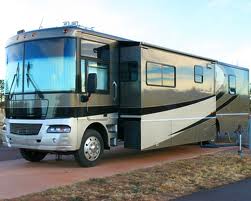RV CLASS A GAS

Generic Description: A RV Class A Gas is a Motorized (Self-Contained) Vehicle built on a truck chassis that is typically 26’ to 38’ long.
When traveling, they are 8’ wide and might have 1 to 4 slide out rooms to extend out when they are parked.
The engines on these are Gasoline Powered and in the Front. The Radiator is usually obvious in the front grille.
The RV Class A Gas, or gasser for short, because of the traditional front engine, will have the two front wheels up in the actual front (see picture above) of the vehicle – before the driver seat - just like an automobile.
A Diesel Class A (Rear Engine) will have the 2 front wheels situated behind the driver seat. Therefore, the diesel will steer and feel very different driving down the road!
Foundation (Chassis): Most Gasoline Front Engine
Chassis RV's are produced from a cargo truck chassis that has been
produced for years. They are all modified to handle an RV Body attached
to them, but they are still your typical traditional heavy duty truck
Chassis.
Since a truck chassis strength is down the center of the length, the RV maker must “beef up” the chassis to handle a large (and heavy) RV Body being attached to it.
Because of the weight and amenities customers want, the diesel configuration along with its strength and durability, has limited the sales/purchasing of the Class A Gasoline RV.
The gas engine up front will also limit some of the
overall floor space. Plus, they will have traditional Hydraulic brakes,
rather than “Air Brakes” of their diesel counterpart.
Be sure to compare the different weight limits per manufacturer, on a standardized sticker attached to the RV ~
Some models will have very little weight left to add you, spouse, clothing, food, water, etc!!!
Body: Just like their diesel counterpart, this is all dependent upon the actual RV “Coach” manufacturer. They will all use different metals and methods to produce a “Cage” to build the walls and ceilings – and protect the occupants.
How it is made and attached to the coach varies. Just like a traditional house, all the pre-work is done before finished walls are in place.
Slide out rooms are very common on the RV Class A Gas as well.
Engines: As the title states, these will all be Gasoline Engine Systems. All the major engine manufacturers are represented here.
Unfortunately, most gasoline engine Class A RV’s are usually an older version. Today’s customers are demanding more and more amenities be added to their coach – pushing them past the Gasoline Engine capability.
Heavy Duty Gasoline Truck Engines are used to their best capability.
Amenities: Unlike a Diesel Class A, a RV Class A Gas
engine has definite weight restrictions – it cannot physically handle
the length or all the upgraded amenities of a diesel.
Many items
will be scaled back, yet still offer all the needed accessories.
Refrigerators will be smaller, countertops lighter, etc.
Utilities: Some will have the 50 Amp service capabilities, but typically 30 Amp service is standard. A RV Class A Gas will have smaller storage and waste tanks – weight is a critical factor.
Generators will be either propane or gasoline fueled.
Accessories: The sky is “almost” the limit here. Weight again plays a key role in this engine type.
Most accessories available to a diesel are potentially available here, just scaled back. It can have jacks, as an example.
But, it cannot have any “airbag” type suspension or leveling capability – it has no "air compressor" like a diesel engine does.
Nicknames: Gas’r, Coach, mini motorhomes
Cost - New: $100,000 to $300,000
Pros: Scaled down, they are a cheaper "rent a motorhome" to obtain. More economical to purchase, annual maintenance cheaper, great entry level RV and a perfect trial rent a motorhome size.
Cons: Ride Quality worse, no air brakes, no engine braking capability (Pac/Jake Brake), amenity restricted (weight!)
No air leveling system for parking, Less storage capability, Not as strong.